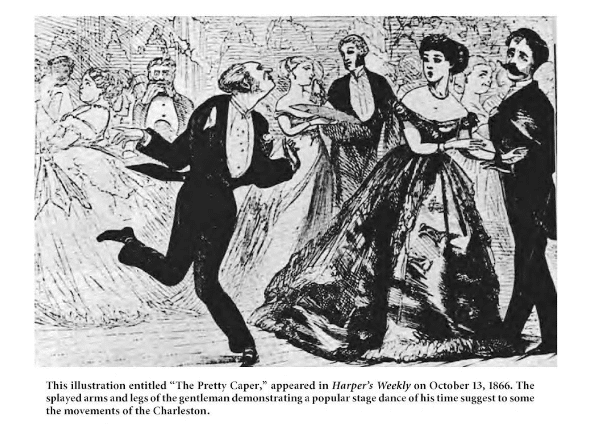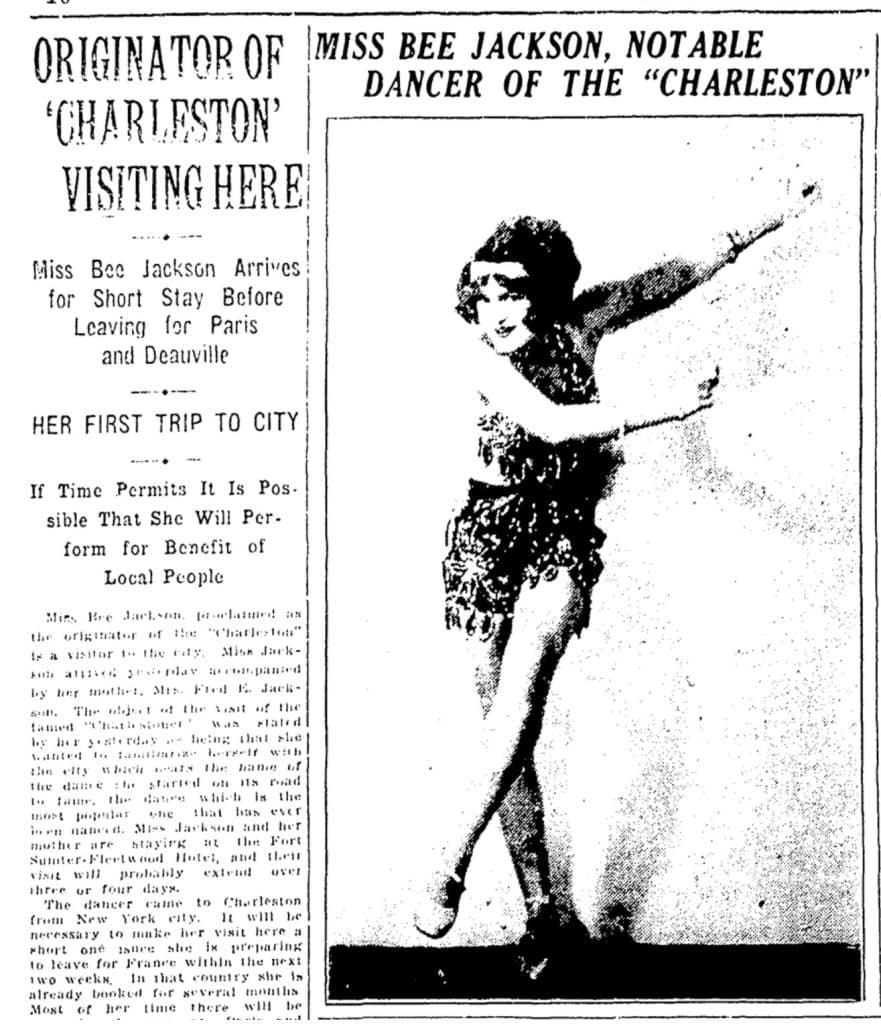On the first part of this article, we discussed how the Charleston dance was born in the city of Charleston, in South Carolina, and the historical/social context of the city during that time. We also covered the main African American dances that influenced the development of this dance style.
Now, on Part 2, we will go further back in history and discover some African and European influences that were taken to the United States and that might have impacted the Charleston. In addition, we’ll also discuss who would have been the first Charleston dancer of their time…
All these different styles of African American dancing that were being developed, mostly in the southern United States, can trace their origins back to various enslaved and trafficked African tribes. As the people were brought to the Americas, so were their traditions, cultural practices, and native dances. As far as the Charleston is concerned, different dance historians recognize the influence of different tribes on the dance.
“According to Marshall and Jean Stearns’ seminal classic Jazz Dance: The Story of American Vernacular Dance, the Charleston bears a striking resemblance to an Obolo dance performed by the Ibo tribe in West Africa. Similarities are also found among dances of the Ashanti and Bari-speaking tribes, and the King Sailor Dance of Trinidad. W. G Raffé states in the Dictionary of Dance that the origin of the Charleston can be traced to a dance called the batuque from the Cape Verde Islands and Portuguese Guinea in West Africa.” [2]
For the Ashanti tribe, for example, music was a part of everyday life, celebrations, religious rituals and even hunting expeditions. It was common to sing while performing communal tasks. This tells us a lot about the habit of enslaved plantation workers singing and dancing during their working days and in their scarce free time.

“Like music, dancing was a form of communication, creative expression and sheer recreation.” [1]
By learning about the culture and traditions of some of these tribes, we can better understand how the traditions of its creators were imbibed into the values of the Charleston and other Jazz dances, specifically innovation, invention, individuality, and improvisation.
“These ritual movements [from African dancing] eventually became more secularized as they were influenced by European stylistic elements introduced to the slaves on the plantations. Although many of the original African rhythms and steps were retained, other aspects were modulated and transformed as European and other influences cross-pollinated with them. This blending eventually morphed into the social dance called the Charleston.” [2]
In an article from 1926, the director of the ballet of the Paris Opera claimed that “the Charleston of today is basically the Branle of the sixteenth century with a few frills added.” The Branle dates back to 1520 and was one of the few Renaissance group dances which was done in a circle, which is a common theme we find in Jazz dancing. Some types of Branle featured miming movements such as pawing the ground like a horse – something we see a lot in Charleston steps. In addition, some forms of the Branle also had a ‘challenge-response’ sequence, which resembles the call-and-response format found in various African dances.
Besides the Branle, other historians believe that the Spanish 18th century pas tortillés, which can be translated as ‘waving steps’, contributed some elements to the Charleston. The description of this dance states that the working foot would turn in and out as it moved, which for sure sounds very familiar for anyone who dances the Charleston.
“The lifting movements of pas levés are recognizable in the dance as well as Rue de Vache (literally translated as the “kick of the cow”) that is seen in the side kick in the Charleston… Elements of the Charleston are also found in the Sailor’s Hornpipe.” [2]

It’s important to consider that many white historians in 1926 would have struggled to admit that such a quintessentially “American” dance phenomenon owed its origins overwhelmingly to Black American and African dance traditions. It’s unsurprising that many would prefer a narrative that focused on ‘clear’ European traces in the dance. Although there were undeniably European influences – for example, in the Cakewalk and marching band music – the fact remains that the Black community of the South reinterpreted those elements through their own cultural lens and we continue to see that flair, style, power, grace, and expression throughout Black American social dances from the 1920s onwards.
There are different stories about who was the first dancer to be seen doing the Charleston steps: Russel Brown, Dan White, and Russel Brooks.
Russel Brown (remember him?) was a musician and member of the Jenkins Band. Willie ‘The Lion’ Smith said that Brown was the first dancer he saw doing this dance, though he also admits that the kids from the Jenkins Orphanage had been doing these types of steps for a while.
Pianist James P. Johnson – composer of the hit tune ‘Charleston’ – shared a different story. He used to play at a club named The Jungles Casino in New York around 1913, where he would spot many Gullah dancers doing their steps. There was a regular dancer named Dan White who, according to Johnson, was the best dancer in the crowd and introduced the Charleston step as we know it.
To add to the possible storylines, here are some crossover details from the two stories above. There is a recording of the Charleston song, played by Willie ‘The Lion’ Smith, in which he spends the first two minutes introducing the song and telling a story about a time when he, James P. Johnson, and Fats Waller were hanging out on the streets of New York when they saw a man from Charleston named Russel Brooks dancing with his crew. Willie says that this was what inspired Johnson to write his famous Charleston tune, although Johnson explains in his autobiography that he was inspired by the dancers in the Jungles Casino.

The fact that there were no Black dancers at the time who either claimed or got credit for being the originators of the dance led to White dancers, such as Bea Jackson and Mildred Melrose, getting nationwide fame as the biggest references in this style. Mildred Melrose toured all across the country between 1925 and 1926 receiving the nickname ‘Queen of the Charleston’ and getting credit for being one of the first to organize Charleston contests. Bea Jackson on the other hand went even further and claimed herself the originator of the dance, using this publicity stunt to gain more popularity and fame. To back up her claim, she needed to promote herself in the city of Charleston, traveling there to take pictures and record short clips, and even requested the keys to the city.
Coverage of Bee Jackson visiting Charleston in the April 15,
1926 edition of the Charleston News and Courier.
Image from Charleston County Public Library.
This appropriation of the dance by White dancers also shows in the fact that it’s extremely hard to find pictures and videos of Black Charleston dancers from the early 1920s. While researching for this article, I was disappointed to not find more photos of Black Charleston dancers from that period for illustration. Josephine Baker seems to be the only reference that we can find – and she got her big break and spent most of her career in France, and not the United States.
Even though we might never find out who the great ‘originator’ of the Charleston was, there are a few thoughts that come up after learning more about its origins. First, all the mentioned supposedly first Charleston dancers were men, which conflicts with the usual feminine flapper image we have of Charleston dancers. If the male-only Jenkins Band did, in fact, originate the Charlston dance, it seems plausible that the first one to do the step was a boy.
Secondly, it seems likely that Charleston was actually recognized as a proper “dance” in New York. As mentioned previously, New York City was, and still is, a cultural and artistic center of the United States. Once a new fad appeared, it became popularized in the City and spread from there throughout the country and abroad. In fact, this happened when the Charleston premiered on the Broadway stage in 1923 – but that is a story for another article. The children of the Jenkins Orphanage traveled often to New York and shared their Geechie steps, which surely was fundamental to the spread of the Charleston dance. However, that means we don’t have any record of who in the City of Charleston itself first came up with that step.
Finally, taking into consideration how African and African American traditions are collective and community-oriented, perhaps we shouldn’t be trying to identify who the very first Charleston dancer was, but rather be looking at it as a collective creation from the Black community of the city of Charleston. It was in the gathering and sharing that different African American dance styles emerged, and maybe that is what should be highlighted.

It’s also easy to see how its usual media portrayal as a dance performed by glamorous white women is very far from its roots. Charleston was a dance created by the Black community in the southern United States, all while being subjected to poor living conditions, with few to no rights and living under Jim Crow laws. It was done by ordinary people in the streets, no need for a fancy ballroom or clothes. It was made by a community of people who were trying to escape the harsh everyday realities of being Black in America.
Researching for this article I struggled to find pictures and clips of Black dancers in the early 1920s… As we look back into this history, it beckons us to reflect about how stories are passed down from generation to generation, who benefits from controlling the narrative, who is erased from the narrative, and why understanding the history of our dance allows us access to the richness of the movement and heritage. You don’t have to dress vintage to dance these dances – you can wear anything you’ve got. You don’t need to attend official classes in order to participate – you can learn it from your friends, on a street corner in New Orleans, or catch a glimpse of it in a modern music video. You can just get together with your buddies and dance.
Online Articles
[3] Black History Month Activities: Play Some Hambone!, Dave Ruch
The history of the Charleston dance, Secrets of Solo
Silents are Golden: 5 Flapper-Themed Films From The 1920s, Classic Movie Hub
The Gullah History and Culture, Lillies of Charleston
The History of Emancipation Day in Charleston, Charleston County Public Library
Rice Culture, Gullah Museum
The Gullah Geechie People, Gullah Geechie Corridor
How Slavery flourished in the United States, National Geographic
Renaissance Dance, Library of Congress
Branle, The Society of Folk Dance Historians (https://www.sfdh.us/encyclopedia/branle.html)
“The Favorite”; the word “choreography”; baroque dance onstage and in the ballroom, in England and in France; Beauchamp-Feuillet notation… and more”, Alastair Macaulay
Books
[1] Doin’ The Charleston – Black Roots of American Popular Music & the Jenkins Orphanage Legacy by Mark R. Jones, 2013
[2] The Wicked Waltz and Other Scandalous Dances by Mark Knowles, 2009
Steppin’ on the Blues by Jacqui Malone, 1996
Jazz Dance by Jean and Marshall Sterns, 1968
A Gullah Guide to Charleston by Alphonso Brown, 2008
Frankie Manning – Ambassador of Lindy Hop, Frankie Manning and Cynthia R. Millman, 2007